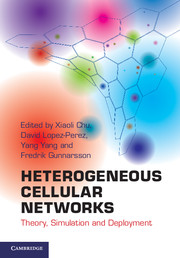Book contents
- Frontmatter
- Contents
- Acknowledgments
- Forewords
- Preface
- List of contributors
- Acronyms
- 1 Introduction
- 2 Radio propagation modeling
- 3 System-level simulation and evaluation models
- 4 Access mechanisms
- 5 Interference modeling and spectrum allocation in two-tier networks
- 6 Self-organization
- 7 Dynamic interference management
- 8 Uncoordinated femtocell deployments
- 9 Mobility and handover management
- 10 Cooperative relaying
- 11 Network MIMO techniques
- 12 Network coding
- 13 Cognitive radio
- 14 Energy-efficient architectures and techniques
- Intex
13 - Cognitive radio
Published online by Cambridge University Press: 05 June 2013
- Frontmatter
- Contents
- Acknowledgments
- Forewords
- Preface
- List of contributors
- Acronyms
- 1 Introduction
- 2 Radio propagation modeling
- 3 System-level simulation and evaluation models
- 4 Access mechanisms
- 5 Interference modeling and spectrum allocation in two-tier networks
- 6 Self-organization
- 7 Dynamic interference management
- 8 Uncoordinated femtocell deployments
- 9 Mobility and handover management
- 10 Cooperative relaying
- 11 Network MIMO techniques
- 12 Network coding
- 13 Cognitive radio
- 14 Energy-efficient architectures and techniques
- Intex
Summary
Introduction
Cognitive radio (CR) has recently become one of the most intensively studied paradigms in wireless communications. In its broadest sense, a CR can be thought of as an enhanced smart software defined radio (SDR). The terms SDR and CRwere introduced by J. Mitola in 1992 [1] and 1999 [2], respectively. SDR, sometimes shortened to software radio, is generally a multi-band radio that supports multiple air interfaces and protocols, and is reconfigurable through software running on a digital signal processor (DSP), field-programmable gate array (FPGA), or general-purpose microprocessor [3]. CR, usually built upon an SDR platform, is a context-aware intelligent radio capable of autonomous reconfiguration by learning from and adapting to the surrounding communication environment [4]. CRs are capable of perceiving and sensing their radio frequency (RF) environment, learning about their radio resources, user equipment (UE), and application requirements, and adapting their configuration and behavior accordingly. From this definition, two main characteristics of CR can be identified: cognitive capability (ability to capture information and learn from the radio environment) and reconfigurability (which enables the transmitter parameters to be dynamically programmed and modified according to the radio environment).
An important specific application often associated with CR is dynamic spectrum access (DSA). DSA, despite being a broader concept [5–7], is commonly understood as the reutilization of licensed RF bands by unlicensed UEs provided that the legitimate licensed UEs are not using the reused frequencies at a given time or in a given region of space.
- Type
- Chapter
- Information
- Heterogeneous Cellular NetworksTheory, Simulation and Deployment, pp. 383 - 425Publisher: Cambridge University PressPrint publication year: 2013
- 29
- Cited by



